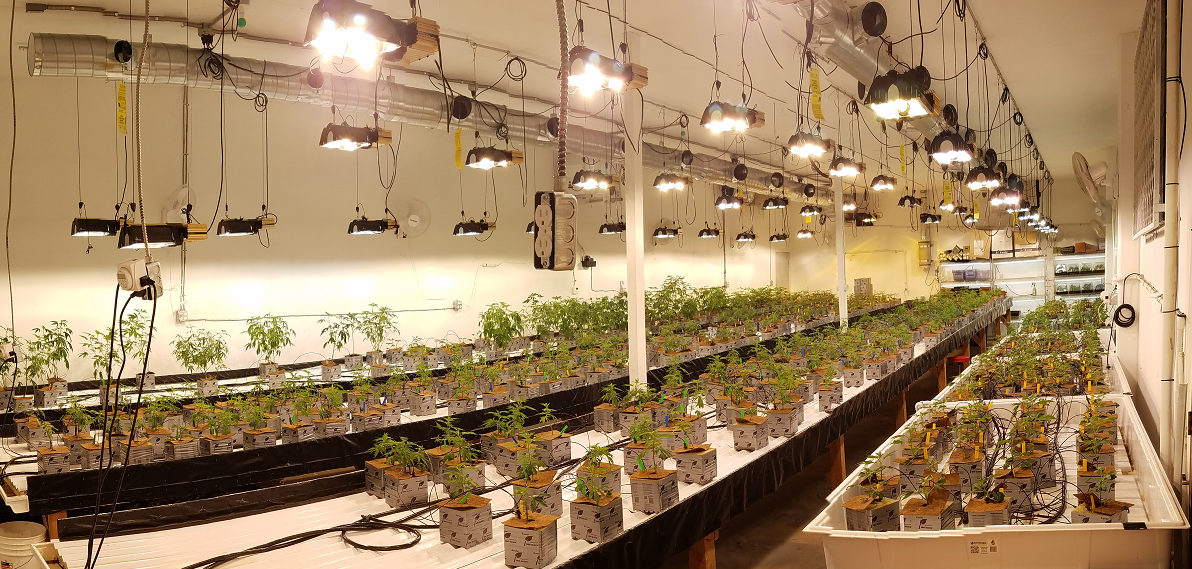
Case Study–Cannabis Grow House In 2017, a Los Angeles County-based grow house, which will go unnamed for security and privacy reasons, contacted us to design and install a security camera system. One of the partners had a copy of his local security requirements for operating the facility, and so we scheduled a free site inspection to survey the property. During the site inspection, we notated the general layout of the facility, noted potential security risks, and recommended cameras and placement that would accommodate the project’s budget while meeting or exceeding the minimum security requirements from the state of CA and City of Los Angeles. On the day of the site inspection, their security consisted of a non-security guard camped out in a trailer on a gated driveway, three dogs, consumer-grade doors and locks, and an intrusion alarm system. The various areas requiring coverage included the entrance, exits, hallways, a large laboratory-style room with expensive lab equipment, several temperature and light-controlled grow rooms, a network/security room with MDF closet where the recorder was to be installed, multiple hallways leading to each of these rooms, and rooftop coverage because of the easy access from a neighboring building. They required at least 90 days […]
Read Now
First, check the VMS’s minimum hardware requirements based on frame rate, bit rate, and expected motion hours. The CPU and GPU you choose should have a higher benchmark score than what is recommended by the VMS calculator. Then, design a server with as many points of redundancy as possible: double or triple-redundant power supply (will be very loud, so ideal for a private equipment room) and dedicated RAID card with BBU with hot spare(s) are required. The server’s storage devices should support the use of each partition, e.g. RAID1 SSDs or SAS drives for the OS, SAS drives for short-term recording, and either SAS or enterprise-grade SATA for long-term archiving. Choose a chassis that is certified for the OS, RAM that is certified for the motherboard (or else Supermicro and other motherboard manufacturers won’t support you), and drives that are compatible with the RAID card. Choose a RAID card that can support external JBOD storage, if future expansion is required. Cloud-based recording/archiving and/or edge storage on devices are additional optional redundancies. My company has been building custom NVR and storage solutions in various form factors (cube, 2U, 3U, 4U, 8U) for all types of organizations including government agencies, museums, police/fire stations, […]
Read Now
This customer from Algeria inquired about our DW (Digital Watchdog) Cube NVR. He admitted not knowing anything about the unit, and gave us the specs his project recommended, which turned out to be for the GV-Tower NVR. Here is the GeoVision GV-Tower NVR. This particular customer requested a system that could handle between 32-48 IP cameras. Not knowing any other details about what kind of cameras he has or what kind of recording and viewing settings his organization will be using, I recommended the Milestone XProtect Express software, or the Digital Watchdog Spectrum software, installed on an eDigitalDeals custom Cube NVR, since that seemed to be his preferred form factor. I also recommended 16GB RAM with SSD hard drive and a dedicated video card, as well as Dual Gigabit-NIC cards. He did not know anything about either VMS (video management software), so I gave him links to both websites so that he could compare the software and download it and make a decision for himself. He then asked what the difference was between the GV-Tower NVR and our hardware. This is what I replied. A copy of the first page of his quote is detailed here: Here was my response […]
Read Now
A hybrid DVR is a DVR that can accept more than one type of video signal. The three most common video signals on the market today are analog, HD-SDI, and IP. It is advantageous to have a hybrid DVR for many reasons, the most significant of which is to utilize existing analog cameras, while adding megapixel cameras to areas that need more detailed monitoring with clear digital zoom-in capabilities. HD cameras can also be used to minimize analog camera count, as they have more pixels and can cover large areas of real estate with a minimal number of cameras. ANALOG CAMERAS Analog, a closed-circuit television system (abbreviated by CCTV), is the traditional video signal, which has been in use for decades, and is typically carried over coaxial cable. In some cases people use Cat5 network cable to send video and even audio and power over network cable with the use of baluns, which are adapters that convert the camera’s BNC connector to RJ45 for Cat5, or to twisted pair, which is common for video-only signals. The typical distance limit for coaxial cable is between 250 to 450 feet, depending on the quality of the cable. With baluns and Cat5 cable, […]
Read Now